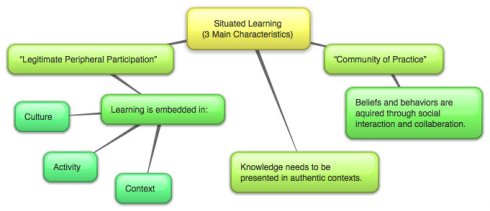Jean Lave is a social anthropologist. In other words, she basically studies how humans act and behave in social groups. Her work has had a significant impact on thinking in regards to cultural studies, sociolinguistics, organizational studies, human geography, and education. Lave’s impact on so many different disciplines goes to show just how big of an influence she has been.

The most well known of Lave’s contributions and ideas is her theory of Situated Learning. Along with Etienne Wenger, she wrote a book titled Situated Learning, introducing two new major concepts: “legitimate peripheral participation” and “communities of practice.”
Situated Learning could not be further removed from direct instruction. Instead, it is closely associated with constructivism, as they both share the idea that knowledge and meaning come from interactions and experiences.
I personally feel that this theory is very strong, because like Lave, I think the world and environment in which we live in is hugely educational, and that much can be learned through our society, culture, daily activities, and interactions. The only weakness of this theory is that it is not actually an educational form, and therefore, sometimes difficult to implement.
The following video demonstrates a way that technology can be integrated into a classroom using the Situated Learning theory. It describes a computer program that is currently being explored and worked on, designed to help teach students English and Language Arts in a non-traditional way. This hands-on activity is a tool that could be very beneficial to students needing a more hands-on approach to a discipline that is normally not taught in a very constructivist way.
A classroom that uses and follows the Situated Learning Theory would provide enriched learning experiences for students by allowing them interactive and hands-on learning activities. Computer based activities would fit in well in this classroom because they allow for authentic interaction amongst the students. This also fosters skills that students will benefit from outside of the classroom. The following ways to incorporate Situated Learning theory were listed on wikipedia:
- Workshops, kitchens, greenhouses and gardens used as classrooms
- Stand-up role playing in the real world setting, including most military training (much of which, though, takes a behaviourist approach)
- Field trips including archaeological digs and participant-observer studies in an alien culture
- On the job training including apprenticeship and cooperative education
- Sports practice, music practice and art are situated learning by definition, as the exact actions in the real setting are those of practice – with the same equipment or instruments
As you can see, this is a theory that can be applied to practically every grade or age group, from kindergarteners all the way up to adults.
Sources:
http://www.learning-theories.com/situated-learning-theory-lave.html

I agree that much of what students learn comes from their environments. Chalk House is an interesting take on improving middle school student literacy. If you think about it, many of the students play video or computer games of some nature in their recreational time anyways and role play games seem to be very popular so it appears to be a great way to tap into student interest while achieving academic goals. I would be interested to see more about it and the assessments it mentioned as well. I can see the ties to improved literacy but unfortunately the video did not really show any writing that students may have to do (or maybe I missed that). At any rate, it seems to be a very logical and engaging step in improving literacy in students.